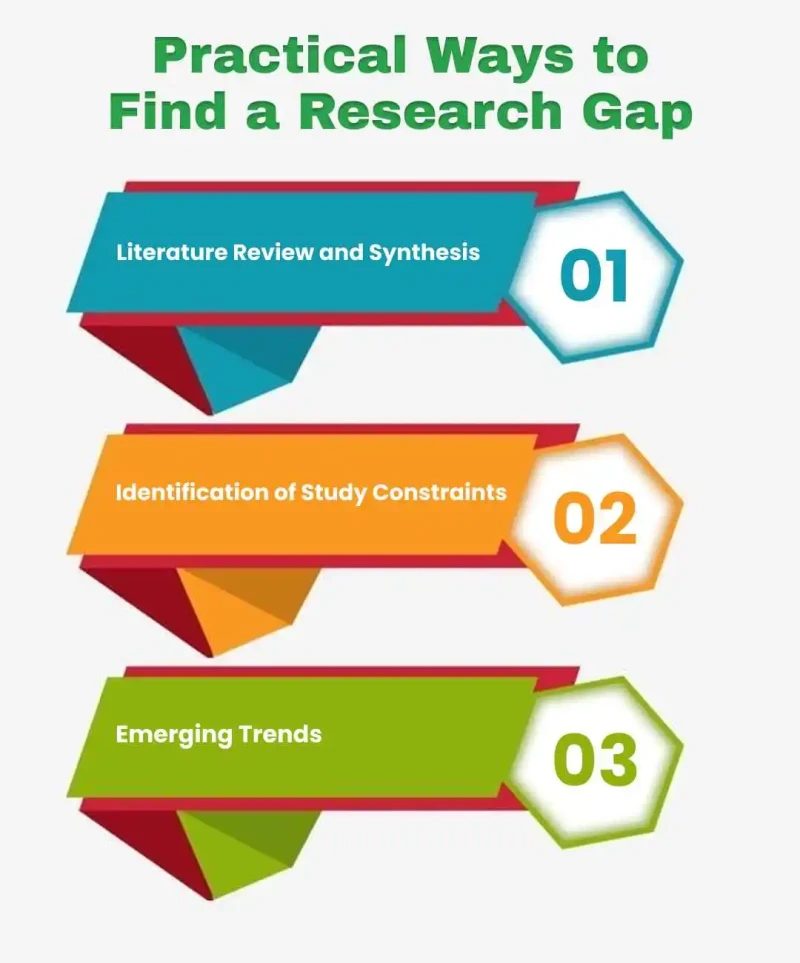
Freena
Every PhD researcher reaches a point where their research appears vague, due to a lack of effort, but because it is difficult to determine what has been missing in existing research. That is where learning how to write a research gap becomes necessary. It is not just an academic requirement; it is the foundation that determines your study's originality and contribution.
A clearly defined gap in the research shows you know your field and have an idea where the knowledge still needs to evolve. More importantly, it strengthens your thesis or dissertation by connecting your proposed work to real, unresolved problems.
A well-executed research methodology shows your critical thinking and ability to connect your study to existing academic discussions. This blog will guide you through writing a research gap, selecting appropriate research methods, and presenting your findings with confidence
It is helpful, before learning how to write a research gap, to recall what the term actually is. A research gap is an under-researched or inadequately researched area in the literature at present, something earlier research has missed, debated, or not adequately explained.
Identifying such a gap is only half the battle. What matters most is how well and clearly you articulate it in your writing. A poorly articulated research gap can make an otherwise sound idea appear woolly or unfocused, but a well-articulated one suggests you know where knowledge stands and where your study fits into it.
Clearly defining your research gap not only guides the direction of your research but also underpins your argument for why your research is needed. It guarantees reviewers and supervisors that your research is original, contextual, and meaningfully contributes to the academic literature.

A successful literature review is the key to identifying research gaps. Analysis of existing studies, identical methodology, and findings allow researchers to state an area as not researched or contentious. Most PhD students are buried under the volume of literature and do not understand how their study can truly make a difference.
There is always some limitation in sample size, method, range, or context in any research study. Passage through those limitations will guide you to the areas for further research and explanation. Researchers are frustrated most often when they feel there is a gap, but do not understand how to explain it, and it holds them up and makes them lose confidence in development.
Keeping pace with the latest trends, technology, and controversy in research generates new areas of research. Reading new topics keeps research current for the times and is more apt to generate seminal work. These researchers cannot associate these trends with their research in the majority of cases, and this downgrades the originality or sense of time significance of the research.
"If you are having trouble delimiting your research gap, you can utilize practical ways and guidance from experts that can identify and delimit it in a precise way."
Our experts guide researchers to scientifically delimit gaps, refine proposals, and delimit research on their own with accuracy and academic integrity.

Begin by introducing your research theme and explaining why it is important in your field. Provide background information, key concepts, along with historical or contemporary developments, which could help us set for the research stage.
Presenting this broader context gives readers a clear understanding of the larger academic landscape and why your research topic is relevant. This frames your study within the bigger picture, making it easier for readers to appreciate the need for the research.
After setting the context, summarise the studies that have already been conducted in your area. It highlights the key findings, methodologies, theoretical frameworks, and contributions of the studies.
This step provides a comprehensive overview of the current state of the research and allows you to identify patterns, consistencies, and contradictions.
A detailed study helps readers understand the existing knowledge base while showing that you have a firm grasp of your field.
Once you have reviewed the literature, identify the limitations or gaps in the existing research. This includes restricted scope, methodological weaknesses, unexamined variables or underexplored contexts. Be sure that the observation appropriately claims the citations.
Clearly articulating that these research gaps are essential because they highlight the area of research when needed. Creating a solid foundation for justifying your own study
Explain why addressing this is important, both in theory and in practice. Discuss the potential implications of filling in the gap, such as advancing knowledge, information policy, improving practice, or contributing to innovation in the field.
Demonstrating the significance of the gap emphasises the value of research and also convinces readers and reviewers that your study is more meaningful and necessary.
Your research gap should be well-structured. Start with the presentation of the overall setting, then move to the literature review, observing gaps or constraints, and the reasons why the gaps are important. End by relating the gap to your research objectives directly. Organising your paragraphs in this way facilitates it to be clear and easy for the reader to trace your argument. Target.
Clear transitions will give more flow to your writing. For instance:
Sample Sentence 1: “Although other studies have examined the effects of employee engagement on productivity, few have investigated how remote work environments influence these outcomes across different organisational cultures.”
Explanation: This bold phrase acknowledges what previous research has done while pointing out what is still missing. It helps you introduce a research gap or highlight the unique contribution of your study.
Sample Sentence 2: “While several studies have explored student motivation in traditional classrooms, they have yet to take into account the impact of hybrid learning models on engagement and academic performance.
Explantion: This bold phrase is used to highlight a gap or limitation in previous research. It signals that while earlier studies may have covered some aspects, there is still something important that has not been considered. Using this phrase helps you introduce the research gap clearly and set the stage for your own study’s contribution.
Sample Sentence 3: Even though there is a lot of research on consumer behavior in online shopping, limited studies have examined the role of mobile app interface design in influencing purchase decisions.
Explanation: This is a simpler way to start a sentence by recognising existing studies but signalling that some aspects are still underexplored. It sets up the context for why your research is necessary.
This string of sentences links the thoughts while explicitly declaring the gap to your readers.
Don't just report on research. Critically discuss the methodology, findings, and limitations of previous research to show where the gap lies. Your goal is to be brief and critical, clearly showing your expertise on the topic and making the gap evident.
Among the common mistakes is writing sentences like "further research is needed" without specifying where and why. Research gaps should clearly specify what area of study needs to be researched. Vagueness offers readers an extra burden to understand the relevance of your research and waters down the impact of your thesis or proposal.
Every gap you've described must be supported by citations, evidence, or concrete examples. To describe a gap without citing simply makes your work appear unsubstantiated. Citing evidence not only supports your argument, but it also shows that your gap analysis is based on an effective literature review.
Carefully distinguish between a research problem and a research gap. The gap is the missing piece or what has not been covered in existing literature, while the problem is the issue your research aims to address. Confusing these two makes your study seem lost or vague.
Always connect the identified gap to your research objectives or questions. Readers should immediately understand how your study addresses the missing area in the literature. Failing to do so can make your research appear disconnected and reduce its academic relevance.
If you’re facing mistakes in writing your research gap or finding it hard to express it effectively, seeking professional assistance can help you refine your ideas, avoid repetition, and present a more impactful, well-structured proposal.
At every point, state your research gap clearly in plain formal scholarly vocabulary. Ambiguity and vagueness can lead to misunderstanding and dilute the effectiveness of your research. Plain scholarly vocabulary enables your readers to grasp the importance of the gap that you are bridging at once.
All assertions of a gap in the literature have to be backed by authoritative and credible sources. Proving that your gap is founded on rigorously established evidence makes your work more credible and indicates that your research rests on the foundations of quality scholarly work.
Make it apparent how your study is contributing something new to what is already known. Demonstrate how your study completes the gap or attacks the issue differently. Emphasising novelty provides your work with originality and elevates its scholarly contribution.
Have your research gap section reviewed by mentors, supervisors, or colleagues to make it rigorous, clear, and as interesting as possible. Feedback makes your own words clearer, makes arguments stronger, and makes your section vibrant and refined.
A well-defined research gap is the cornerstone of any successful PhD study. It not only demonstrates your deep understanding of the subject but also highlights the originality and significance of your research. By focusing on clarity, strong evidence, and clear alignment with your research objectives, you build a study that stands out in both academic and practical value.
If you’re finding it challenging to identify or articulate your research gap, getting expert PhD guidance can make the process smoother and more strategic, helping you strengthen your methodology and set a solid foundation for a high-impact thesis or dissertation.

Top 5 Best Literature Review Writing Service for PhD Scholars

Difference Between Thesis and Synopsis: A Complete Guide for Academic Clarity

Types of Literature Review Comprehensive Guide for Scholars

Best PhD Assistance Services

The Top 6 Best Research Paper Writing Services